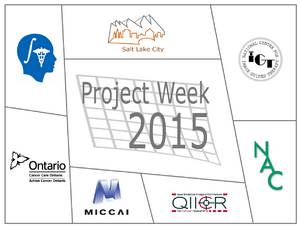Difference between revisions of "2015 Winter Project Week"
| Line 116: | Line 116: | ||
*Tracked ultrasound benchtop experment system for neurosurgery (Steve Pieper, Jim Miller) | *Tracked ultrasound benchtop experment system for neurosurgery (Steve Pieper, Jim Miller) | ||
*Case review for interactive registration (Steve Pieper, Jim Miller, Alireza Mehrtash) | *Case review for interactive registration (Steve Pieper, Jim Miller, Alireza Mehrtash) | ||
| + | *Workflow for percutaneous needle place (Bamshad Azizi, Li Ming, Li Ye, Kevin Cleary) | ||
==Huntington's Disease== | ==Huntington's Disease== | ||
Revision as of 20:52, 11 December 2014
Home < 2015 Winter Project WeekWelcome to the 20th Project week page!
Introduction
Founded in 2005, the National Alliance for Medical Image Computing (NAMIC), was chartered with building a computational infrastructure to support biomedical research as part of the NIH funded NCBC program. The work of this alliance has resulted in important progress in algorithmic research, an open source medical image computing platform 3D Slicer, built using VTK, ITK, CMake, and CDash, and the creation of a community of algorithm researchers, biomedical scientists and software engineers who are committed to open science. This community meets twice a year in an event called Project Week.
Project Week is a semi-annual event which draws 80-120 researchers. As of August 2014, it is a MICCAI endorsed event. The participants work collaboratively on open-science solutions for problems that lie on the interfaces of the fields of computer science, mechanical engineering, biomedical engineering, and medicine. In contrast to conventional conferences and workshops the primary focus of the Project Weeks is to make progress in projects (as opposed to reporting about progress). The objective of the Project Weeks is to provide a venue for this community of medical open source software creators. Project Weeks are open to all, are publicly advertised, and are funded through fees paid by the attendees. Participants are encouraged to stay for the entire event.
Project Week activities: Everyone shows up with a project. Some people are working on the platform. Some people are developing algorithms. Some people are applying the tools to their research problems. We begin the week by introducing projects and connecting teams. We end the week by reporting progress. In addition to the ongoing working sessions, breakout sessions are organized ad-hoc on a variety of special topics. These topics include: discussions of software architecture, presentations of new features and approaches and topics such as Image-Guided Therapy.
Several funded projects use the Project Week as a place to convene and collaborate. These include NAC, NCIGT, QIICR, and OCAIRO. The next events in this ongoing series will occur in Salt Lake City, Utah in January of 2015, followed by one in Boston, MA in June of 2015.
A summary of all previous Project Events is available here.
This project week is an event endorsed by the MICCAI society.
Please make sure that you are on the na-mic-project-week mailing list
Logistics
- Dates: January 5-9, 2015.
- Location: Salt Lake City, Utah
- REGISTRATION: Please click here to register online before December 24, 2014. All participants must pay a registration fee 550 USD, which covers our catering and facilities costs.
- Venue: The venue for the meeting is the Marriott City Center, Salt Lake City, Utah. You can book online, by clicking here. The room rate for the meeting is 149 USD per night.
Agenda
| Time | Monday, January 5 | Tuesday, January 6 | Wednesday, January 7 | Thursday, January 8 | Friday, January 9 |
| Project Activities (Olympus B) |
Project Activities (Olympus B) |
Project Activities (Olympus B) |
Project Activities (Olympus B) |
Project Activities (Olympus B) | |
| 7:30-8:00 | Breakfast (Olympus A) |
Breakfast (Olympus A) |
Breakfast (Olympus A) |
Breakfast (Olympus A) | |
| 8:00-10:00 | 9-10am: Breakout Session:COPD (Raul San Jose) (Amethyst 1) |
9-10am: Breakout Session:QIICR and DICOM (Andrey Fedorov, Steve Pieper) (Amethyst 1) |
Project Activities (Olympus B) |
9am: Project Presentations (Olympus B) | |
| 10:00-10:30 | Coffee (General area) |
Coffee (General area) |
Coffee (General area) |
Coffee (General area) | |
| 10:30-12:00 | Project Activities (Olympus B) |
||||
| 12:00-1:00 | Lunch (Olympus A) |
Lunch (Olympus A) |
Lunch (Olympus A) |
Lunch (Olympus A) |
Boxed Lunch and Adjourn (Olympus A) |
| 1:00-3:00l | Project Presentations (Olympus B) |
Slicer Workshop (Ron Kikinis) | (Olympus B) | ||
| 3:00-3:30 | Coffee (General area) |
Coffee (General area) |
Coffee (General area) |
Coffee (General area) |
|
| 3:00-5:00 | 3:15-4pm: Breakout Session: Segmentations (Amethyst 2) |
Project Activities (Olympus B) |
|||
| 05:00-07:00 | 6:00 Optional: Beer at Murphy's (like last year) |
Projects
Image-Guided Therapy
- Image-based Needle Detection from MRI (Andre Mastmeyer, Guillaume Pernelle, Tina Kapur)
- Tracked ultrasound benchtop experment system for neurosurgery (Steve Pieper, Jim Miller)
- Case review for interactive registration (Steve Pieper, Jim Miller, Alireza Mehrtash)
- Workflow for percutaneous needle place (Bamshad Azizi, Li Ming, Li Ye, Kevin Cleary)
Huntington's Disease
TBI
Stroke
Cardiac
Chronic Obstructive Pulmonary Disease, Lung, Chest
Head and Neck Cancer / Radiotherapy
QIICR
- Mechanism to pull related DICOM series on derived modality load (Andrey, Csaba)
- Segmentation object and enhanced multiframe object IO in DCMTK and Slicer (Steve, Andrey, Michael)
- T1 mapping for variable flip angle (Artem, Xiao, Andrey)
Feature Extraction
Additional Brain Image Analysis
Slicer4 Extensions
TMJOA RO1 - Collaboration with NAMIC
- Improved model display (Francois Boudin, Steve Pieper)
Infrastructure
- Rulers in Markups module (Nicole Aucoin)
Registrants
Do not add your name to this list - it is maintained by the organizers based on your paid registration. (The Registration Page is Coming Soon, so please give us a few days.)
